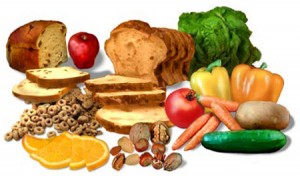
Dietary fiber is a very important essential nutrient that the average person fails to consume enough of on a daily basis. The recommended intake is 25-30 grams of fiber daily, or 14 grams per every 1,000 calories consumed. A healthy diet rich in whole grains, vegetables, fruits, and beans/legumes will provide most of the fiber you need and will also assist in weight control. Fiber is necessary for effective digestion and for elimination of waste products. A high fiber diet may also lower your risk for chronic disease such as diabetes, heart disease, and certain types of cancer.
What is fiber? Simply put, fiber is the parts of plant foods that are not digested by the human body. Fiber is a complex carbohydrate that has no calorie value. Fiber is found in plant foods such as fruits, vegetables, whole grain: breads, cereals, pasta and rice, beans, peas, lentils, nuts and seeds. Meat, poultry, fat, milk and dairy products do not contain fiber.
There are two types of fiber—soluble and insoluble. Soluble fiber helps lower blood cholesterol, control blood sugar and makes you feel full after a meal (satiety). Good sources of soluble fiber include oat bran, oatmeal, barley, rye, peas, beans, carrots, apples and oranges. Insoluble fiber is not dissolved by water and is not destroyed by bacteria in the colon. Insoluble fibers work mainly in the colon where they add bulk and help retain water promoting gastro-intestinal health. Good sources for insoluble fiber are fruits, vegetables, beans, wheat bran, brown rice and whole grains. Fiber rich foods (foods containing 5 or more grams of fiber per serving) usually have both soluble and insoluble fiber and a high-fiber diet should provide enough of each type.
Four Easy Ways to Increase Your Fiber Intake:
Choose whole grain foods more often. Whole grains are foods made from the entire grain seed, usually called the kernel, which consists of the bran, germ, and endosperm. If the kernel has been cracked, crushed, or flaked, it must retain nearly the same relative proportions of bran, germ, and endosperm as the original grain in order to be called whole grain.
- Start your day with a high-fiber breakfast. Oatmeal is always a good choice – try the old fashioned rolled oats rather than the instant oatmeal that is usually high in sugar.
- Get enough fruits and veggies each day! When you are fixing your plate at mealtime – try to fill half the plate (or more) with fruits and veggies rather than meat and starches.
- Enjoy beans more often. Beans are high in fiber and many other essential nutrients. They are naturally low in fat and a good source of protein. Another plus is that they are a very economical choice for a meal!











